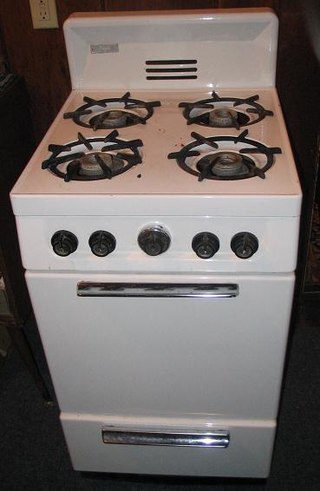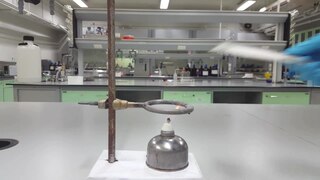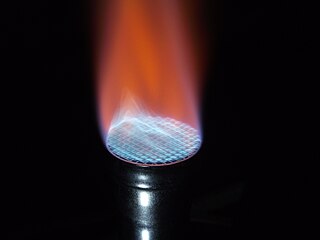An alcohol burner or spirit lamp is a piece of laboratory equipment used to produce an open flame. It can be made from brass, glass, stainless steel or aluminium. [1]
An alcohol burner or spirit lamp is a piece of laboratory equipment used to produce an open flame. It can be made from brass, glass, stainless steel or aluminium. [1]
Alcohol burners are preferred for some uses over Bunsen burners for safety purposes, and in laboratories where natural gas is not available. Their flame is limited to approximately 5 centimeters (two inches) in height, with a comparatively lower temperature than the gas flame of the Bunsen burner. [2] [3]
While they do not produce flames as hot as other types of burners, they are sufficiently hot for performing some chemistries, standard microbiology laboratory procedures, and can be used for flame sterilization of other laboratory equipment. [4] [5]
A small alcohol burner is also preferred for camping when the need for fire is modest. It burns the alcohol vapor that raises due to the heat from the flame through the holes on the top perimeter of the container.


Typical fuel is denatured alcohol, methanol, or isopropanol. [2] [3] A cap is used as a snuffer for extinguishing the flame.

Atomic absorption spectroscopy (AAS) and atomic emission spectroscopy (AES) is a spectroanalytical procedure for the quantitative determination of chemical elements by free atoms in the gaseous state. Atomic absorption spectroscopy is based on absorption of light by free metallic ions.

A Bunsen burner, named after Robert Bunsen, is a kind of ambient air gas burner used as laboratory equipment; it produces a single open gas flame, and is used for heating, sterilization, and combustion.

A test tube, also known as a culture tube or sample tube, is a common piece of laboratory glassware consisting of a finger-like length of glass or clear plastic tubing, open at the top and closed at the bottom.

A portable stove is a cooking stove specially designed to be portable and lightweight, used in camping, picnicking, backpacking, or other use in remote locations where an easily transportable means of cooking or heating is needed. Portable stoves can be used in diverse situations, such as for outdoor food service and catering and in field hospitals.

Sterilization refers to any process that removes, kills, or deactivates all forms of life and other biological agents such as prions present in or on a specific surface, object, or fluid. Sterilization can be achieved through various means, including heat, chemicals, irradiation, high pressure, and filtration. Sterilization is distinct from disinfection, sanitization, and pasteurization, in that those methods reduce rather than eliminate all forms of life and biological agents present. After sterilization, an object is referred to as being sterile or aseptic.

A hot plate is a portable self-contained tabletop small appliance cooktop that features one or more electric heating elements or gas burners. A hot plate can be used as a stand-alone appliance, but is often used as a substitute for one of the burners from an oven range or a kitchen stove. Hot plates are often used for food preparation, generally in locations where a full kitchen stove would not be convenient or practical. They can also be used as a heat source in laboratories. A hot plate can have a flat surface or round surface. Hot plates can be used for traveling or in areas without electricity.

A beverage-can stove, or pop-can stove, is a do it yourself, ultralight, alcohol-burning portable stove. It is made using parts from two aluminium beverage cans. Basic designs can be relatively simple, but many variations exist.

A gas stove is a stove that is fuelled by combustible gas such as syngas, natural gas, propane, butane, liquefied petroleum gas or other flammable gas. Before the advent of gas, cooking stoves relied on solid fuels such as coal or wood. The first gas stoves were developed in the 1820s and a gas stove factory was established in England in 1836. This new cooking technology had the advantage of being easily adjustable and could be turned off when not in use. The gas stove, however, did not become a commercial success until the 1880s, by which time supplies of piped gas were available in cities and large towns in Britain. The stoves became widespread on the European Continent and in the United States in the early 20th century.

Trangia is a line of alcohol-burning portable stoves manufactured by Swedish company Trangia AB in Trångsviken. These stoves are designed primarily for backpackers, with a focus on light weight, durability and simple design. The company began in 1925, selling cookware. The Trangia stove was developed by 1951. Trangia stoves were initially preferred to kerosene (paraffin) pressure stoves because they required only one type of fuel. Trangia's selling point is that the entire packaged stove, including pots, is not significantly larger than a standard camp cooking pot. For this reason the Trangia has retained much of its popularity despite the development of alternative stove fuels and designs.

The Primus stove was the first pressurized-burner kerosene (paraffin) stove, developed in 1892 by Frans Wilhelm Lindqvist, a factory mechanic in Stockholm. The stove was based on the design of the hand-held blowtorch; Lindqvist’s patent covered the burner, which was turned upward on the stove instead of outward as on the blowtorch. The same year, Lindqvist partnered with Johan Viktor Svenson and established J.V. Svenson’s Kerosene Stove Factory for manufacturing the new stoves which were sold under the name Primus. The first model was the No.1 stove, which was quickly followed by a number of similarly-designed stoves of different models and sizes. Shortly thereafter, B.A. Hjorth & Co., a tool and engineering firm begun in Stockholm in 1889, acquired the exclusive rights to sell the Primus stove.

A gas burner is a device that produces a non-controlled flame by mixing a fuel gas such as acetylene, natural gas, or propane with an oxidizer such as the ambient air or supplied oxygen, and allowing for ignition and combustion.

Wire gauze or wire mesh is a gauze woven of metal wire, or very fine, gauze-like wire netting. Wire gauze is placed on the support ring that is attached to the retort stand between a burner and glassware, or is placed on a tripod to support beakers, flasks, or other glassware to protect it during heating. Glassware should not be heated directly by the flame of a Bunsen or other gas burner; wire gauze diffuses the heat and protects the glassware. Glassware has to be flat-bottomed if rested on the wire gauze.

A water bath is laboratory equipment made from a container filled with heated water. It is used to incubate samples in water at a constant temperature over a long period of time. Most water baths have a digital or an analogue interface to allow users to set a desired temperature, but some water baths have their temperature controlled by a current passing through a reader. Utilisations include warming of reagents, melting of substrates or incubation of cell cultures. It is also used to enable certain chemical reactions to occur at high temperature. Water baths are preferred heat sources for heating flammable chemicals, as their lack of open flame prevents ignition. Different types of water baths are used depending on application. For all water baths, it can be used up to 99.9 °C. When temperature is above 100 °C, alternative methods such as oil bath, silicone bath or sand bath may be used.

A Meker–Fisher burner, or Meker burner, is an ambient air laboratory burner that produces multiple open gas flames, used for heating, sterilization, and combustion. It is used when laboratory work requires a hotter flame than attainable using a Bunsen burner, or used when a larger-diameter flame is desired, such as with an inoculation loop or in some glassblowing operations. The burner was introduced by French chemist Georges Méker in an article published in 1905.

The Teclu burner is an ambient air laboratory gas burner, that was created by Romanian chemist Nicolae Teclu in 1882. The burner is most commonly used to heat substances in a laboratory, can be used for sterilisation and sometimes it is used for soldering or glasswork. It is commonly made from brass or iron.The burner physically consists of a round base, a tube connected to it providing the gas to the flame and a vertical metal tube that directs the flame upwards. The tube has a conical shape closer to the base.

A luminous flame is a burning flame which is brightly visible. Much of its output is in the form of visible light, as well as heat or light in the non-visible wavelengths.

A splint is a simple piece of equipment used in scientific laboratories. Splints are typically long, thin strips of wood, about 6 inches (15 cm) long and ¼ inch (6 mm) wide, and are consumable but inexpensive. They are typically used for tasks such as lighting bunsen burners, as the length of the splint allows a flame to be lit without risk to the user's hand, should the burner flare back. Another use for splints are chemical identification of various gases, and splints are also used to teach simple chemical principles in schools.Also in homes.
Many laboratories contain significant risks, and the prevention of laboratory accidents requires great care and constant vigilance. Examples of risk factors include high voltages, high and low pressures and temperatures, corrosive and toxic chemicals and chemical vapours, radiation, fire, explosions, and biohazards including infective organisms and their toxins.

An inoculation needle is a laboratory equipment used in the field of microbiology to transfer and inoculate living microorganisms. It is one of the most commonly implicated biological laboratory tools and can be disposable or re-usable. A standard reusable inoculation needle is made from nichrome or platinum wire affixed to a metallic handle. A disposable inoculation needle is often made from plastic resin. The base of the needle is dulled, resulting in a blunted end.

In microbiology, a cell spreader or plate spreader is a tool used to smoothly spread cells and bacteria on a culture plate, such as a petri dish.